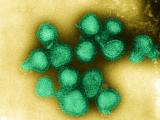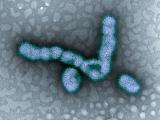Dec 30, 2011
H1N1 antibody response in kids may correlate with disease severity
Natural infection with 2009 H1N1 pandemic influenza virus (pH1N1) confers seroprotective antibody titers in children, the immune response correlating with the severity of disease but not with previous immunity to seasonal H1N1, according to findings from a study in Virology Journal. The study group comprised 69 otherwise healthy children with confirmed pH1N1 infection. Antibody levels against pH1N1 and seasonal H1N1 flu viruses were determined through hemagglutination-inhibiting antibody levels. Seroprotective antibody levels (>40) against pandemic H1N1 were present in 64 children (92.8%) and against seasonal H1N1 in only 28 (40.6%). Those protected against seasonal H1N1 were significantly older, more often hospitalized, more likely to have pneumonia, and more often treated with oseltamivir. Those with the most severe disease, as determined by need for hospitalization and presence of pneumonia, showed the highest antibody response against the pandemic virus.
Dec 30 Virol J article
Study: H1N1 transmissibility likely due to constellation of genes
The high transmissibility of the pH1N1 flu was likely due to the influence of a constellation of genes, say the authors of a ferret study in PLoS Pathogens. The researchers sought to evaluate why the pandemic virus was able to spread efficiently from person to person, unlike its precursor viruses, North American triple reassortant swine and a Eurasian swine virus. They found that viral replication was not the deciding factor (all the viruses replicated efficiently in the upper respiratory tract of infected ferrets). Rather, increased viral neuraminidase activity and production of filamentous viral particles in the Eurasian-origin gene segments appeared to play the largest role. On the basis of their findings, the authors recommend that the pandemic potential of novel influenza viruses be assessed by characterizing phenotypes important for transmission, such as viral replication in the upper respiratory tract of ferrets, release of respirable influenza virus-containing particles, and receptor specificity.
Dec 29 PLoS Pathog article
Vietnamese study finds high H1N1 seroprevalence in slaughterhouse pigs
More than half of pigs at a Vietnamese slaughterhouse had antibodies to pH1N1 influenza, according to a study today in Influenza and Other Respiratory Viruses. The study involved specimens from virologic and serologic surveillance in 2009-10 on pig farms (38 swabs and 1,732 sera) and at a pig slaughterhouse (710 swabs and 459 sera) in northern Vietnam. Researchers screened the sera with an influenza A ELISA assay and then tested positive sera with hemagglutination inhibition tests for antibodies. The team found a maximum pH1N1 seroprevalence in the slaughterhouse of 55.6% (95% confidence interval [CI], 38.1%-72.1%) at the end of December 2009, 2 weeks after human cases in the area peaked. Farm-level seroprevalence was 29% (95% CI, 23.2%-35.7%), and, on seropositive farms, within-herd seroprevalence ranged from 10% to 100%. The authors conclude, "Our findings suggest extensive reverse-zoonotic transmission from humans to pigs with subsequent onward transmission within pig herds."
Dec 30 Influenza Other Respi Viruses abstract



















